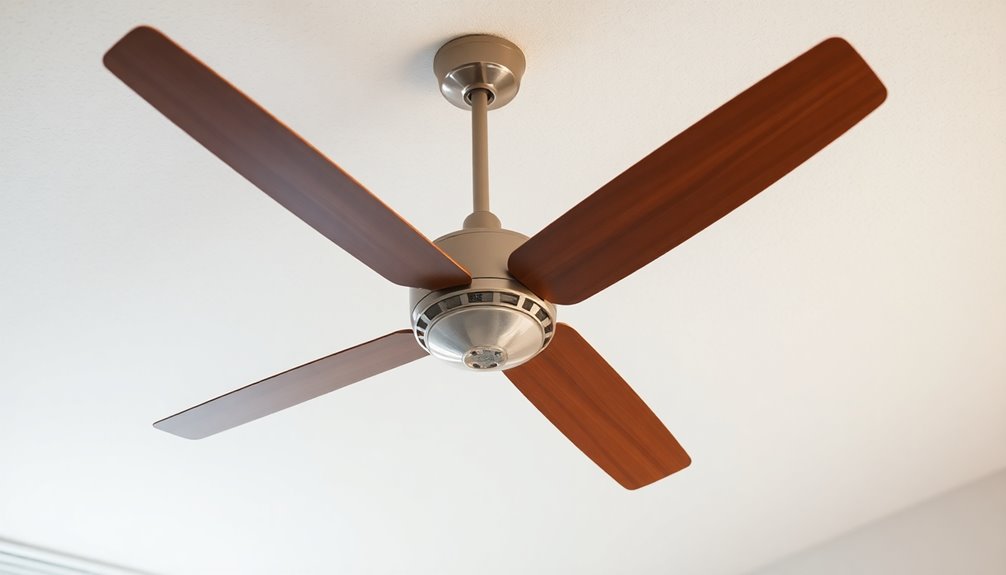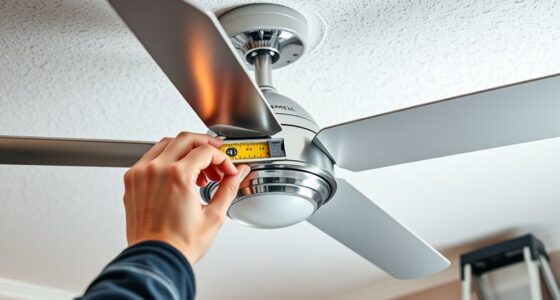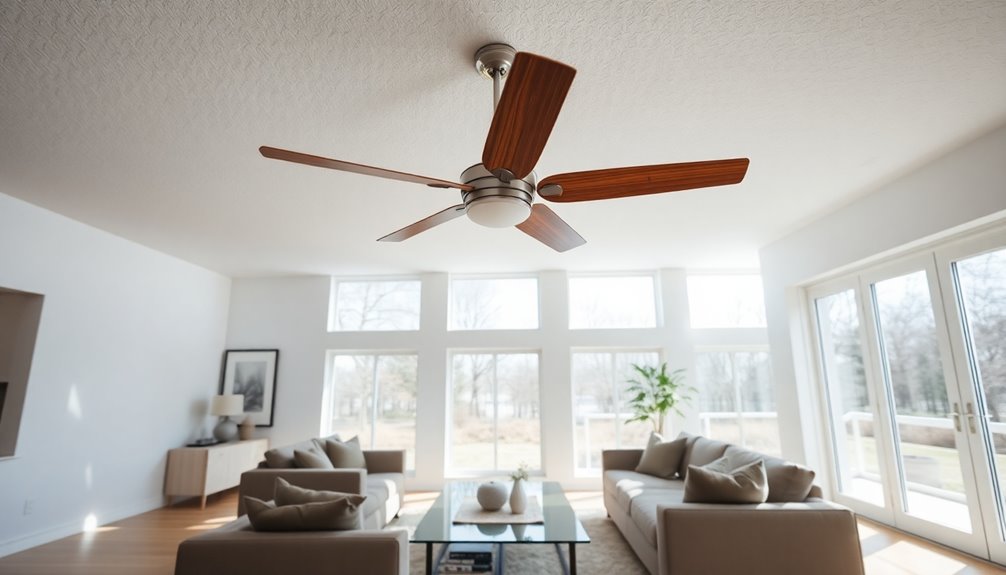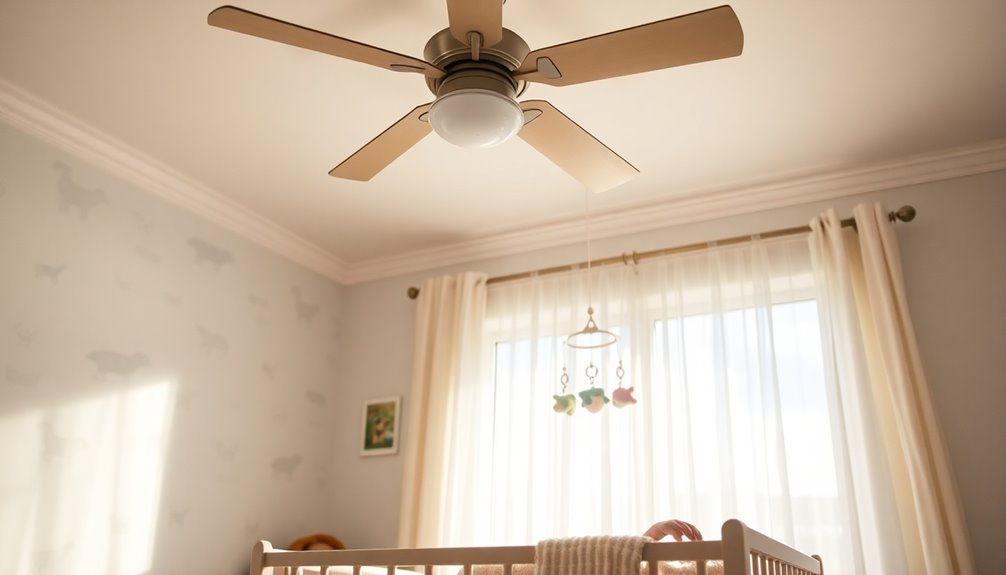You can technically put longer blades on a ceiling fan, but it's risky. While longer blades may boost airflow, they can strain the motor and cause overheating. Manufacturers typically recommend sticking to blades only 2-3 inches longer than the original to avoid balance issues and wobbling. Installing longer blades can also void your warranty. For your safety and to maintain performance, consult with a specialist before making any changes. If you're looking for effective ways to improve air circulation, there are other alternatives to evaluate that might be more suitable and safer.
Key Takeaways
- Installing longer blades on a ceiling fan is not recommended due to risks of motor strain and overheating.
- Blade length modifications should only exceed the original size by 2-3 inches to avoid performance issues.
- Longer blades can lead to imbalance, causing wobbling, noise, and potential safety hazards.
- Consult manufacturer guidelines and specialists before making any changes to ensure compatibility and safety.
- Consider alternative solutions like larger fans or fans with steeper blade pitches for improved airflow without modifying existing blades.
Current Ceiling Fan Performance

The current ceiling fan struggles to provide adequate airflow, especially with its 18.5-inch blades weighing 2 lbs 10 oz.
Even when you crank it up to the highest speed setting, you'll notice it simply doesn't move enough air, especially in your gazebo with a ceiling height ranging from 8 to 9 feet.
This limited air movement can become a real issue during hot and humid weather when you need relief the most.
You might be tempted to replace the blades with longer ones, like the 20.5-inch variety weighing 3 lbs 12 oz, but that's not without its risks.
The manufacturer, Hampton Bay, specifically advises against using longer blades due to potential motor strain and overheating.
Ignoring these guidelines could lead to cumulative damage to the fan motor, putting both safety and performance at risk.
Considerations for Longer Blades

Upgrading to longer ceiling fan blades might seem like a quick fix for improving airflow, but several important factors need your attention first. While longer blades can enhance air distribution, you should limit their length to just 2-3 inches longer than the original blades to prevent excessive strain on the motor.
Manufacturers like Hampton Bay advise against using longer blades, as they can lead to overheating and increased wear on the motor.
Additionally, the added weight of longer blades may create an imbalance, requiring you to carefully install them and possibly use balance kits to guarantee smooth operation.
Drilling new holes for blade attachment can also compromise the structural integrity of your ceiling fan, so precision is vital to avoid safety hazards.
Before making any modifications, it's wise to consult with ceiling fan specialists or manufacturers. This guarantees you comply with safety standards and don't inadvertently void your warranty.
Manufacturer Recommendations

When considering changes to your ceiling fan, it's crucial to heed manufacturer recommendations to guarantee safety and peak performance. Most manufacturers, like Hampton Bay, specifically advise against using longer blades. This caution stems from potential safety risks and performance issues that can arise when you alter fan specifications. Changing blade sizes can lead to cumulative damage to the motor, increasing the risk of overheating and malfunction.
Additionally, safety codes dictate that you should review ceiling fan RPM limits before making modifications. Ignoring these guidelines can compromise the structural integrity of your fan, which could result in accidents or damage to your home. Most manufacturers emphasize the importance of sticking to their recommendations to maintain ideal performance and avoid voiding warranties.
To stay safe and compliant, it's wise to consult with the manufacturer or a ceiling fan specialist before making any changes to the fan blades. They can provide specific guidance on what modifications are acceptable and what risks you might face if you choose to ignore the manufacturer recommendations.
Alternative Solutions

If you're looking for better airflow, consider purchasing a larger ceiling fan or adjusting its mounting height.
Sometimes, just lowering the fan can enhance performance without the hassle of changing blades.
Additionally, exploring fans with a steeper blade pitch or adding extra fans in larger spaces can make a significant difference in comfort.
Additional Fan Options
Exploring alternative solutions for ceiling fans can lead to better airflow and cooling efficiency without the hassle of modifying existing blades.
One effective option is to contemplate purchasing a larger ceiling fan designed specifically for improved airflow. You can find models available for around $100 that might outperform your current fan with new fan blades.
Additionally, look for fans that feature a steeper blade pitch, as they're engineered to enhance air movement, resulting in superior cooling performance. Instead of altering existing specifications, explore different fan models that already come with larger blades, ensuring you avoid any risks associated with modifications.
If you're using your fan in an outdoor setting, evaluate the option of lowering its mounting height. This adjustment can greatly enhance airflow, especially in spaces like gazebos with 8 to 9 feet ceilings.
Lastly, don't overlook regular maintenance of your existing fan. Cleaning and checking for balance can improve its performance without needing any changes to the blades.
Ceiling Height Adjustments
Adjusting the height of your ceiling fan can greatly boost its performance and efficiency in circulating air. By lowering the fan, you reduce the distance between the fan blades and the space that needs cooling, which is particularly effective in rooms with ceiling heights of 8 to 9 feet. This adjustment enhances airflow, guaranteeing you feel the breeze more intensely.
In outdoor settings, where air movement is vital, adjusting the installation height can markedly improve air distribution, especially during hot, humid days. You can achieve a steeper blade pitch by modifying the mounting height, resulting in better air movement without needing to replace the blades.
It's essential to install the fan at a height that allows for unobstructed airflow, particularly in areas like gazebos, where air movement is often limited.
Regularly evaluating and adjusting your fan's position will help you maximize its performance, especially if you notice decreased airflow at the highest speed. By making these ceiling height adjustments, you can enhance your fan's efficiency and guarantee that you stay cool and comfortable all season long.
Installation Risks and Precautions

Installing longer blades on a ceiling fan can introduce various risks that you need to be aware of to guarantee a safe and effective operation. One significant concern is the potential for imbalance. If the new blades aren't mounted correctly, you may face wobbling and excessive noise during operation.
To avoid this, make sure to mark the original positions of the fan blades before removal. This helps maintain proper alignment and balance when installing the new blades.
Another risk involves the fan motor, which may experience added strain due to the increased load from longer blades. If the motor isn't designed to handle this extra weight and size, it could lead to overheating and eventual failure.
Always check the fan's RPM limits and safety codes to verify your installation complies with manufacturer specifications.
Finally, consider using a balance kit after installation. This can help mitigate any wobbling or instability caused by the new blades, enhancing both safety and efficiency.
Expert Recommendations

When considering ceiling fan blade length, safety and compliance should be your top priorities.
Experts recommend sticking to manufacturer guidelines to guarantee peak performance and efficiency.
Consulting a professional can help you navigate any modifications and avoid costly mistakes.
Safety and Compliance Issues
Guaranteeing safety and compliance with ceiling fan blade length is fundamental for both ideal performance and your peace of mind. Manufacturers typically advise against using longer blades than specified because this can lead to motor strain, overheating, and potential malfunctions.
Ignoring these guidelines not only poses safety hazards but may also void your warranty, emphasizing the need to adhere to manufacturer instructions.
If you're considering modifying your ceiling fan, it's essential to consult with a professional or the manufacturer to confirm any changes align with safety codes and operational limits. Proper balance and alignment are critical when altering blade sizes; imbalances can cause noise, vibrations, and increased wear on the fan motor.
After any modifications, regularly monitor the motor's temperature and performance. This step is fundamental to prevent overheating and maintain safe operation.
Performance and Efficiency Factors
Ideal performance and energy efficiency in ceiling fans hinge on several key factors, including blade length and pitch. While longer blades can enhance air circulation, they must align with the fan's motor specifications. If not, you risk overheating and decreased efficiency. Adhering to manufacturer guidelines is essential for peak performance and warranty protection.
| Factor | Impact on Performance | Efficiency |
|---|---|---|
| Blade Length | Can improve airflow distribution | Must match motor specs |
| Blade Pitch | A steeper pitch enhances airflow | More effective than length alone |
| Weight of Blades | Additional strain on motor | Risks malfunctions |
| Manufacturer Specs | Guarantees safe modifications | Maintains efficiency standards |
Keep in mind that the weight and length of longer blades can strain the motor, leading to potential malfunctions. Instead of just increasing blade length, consider adjusting the blade pitch for improved airflow without compromising performance. Always consult ceiling fan specialists before making any modifications to guarantee safety and maintain efficiency.
Professional Consultation Importance
Consulting with professionals about ceiling fan blade changes is fundamental for maintaining safety and performance. When you consider altering the blade size, you risk compatibility issues that could lead to safety hazards. Experts emphasize that changing blade sizes can strain the motor, potentially causing it to overheat or malfunction. Furthermore, improper adjustments can lead to increased fire risks, particularly if the fan operates unsafely due to the added strain.
That's why getting professional consultation is essential in selecting the appropriate blade size for your fan. Licensed electrical contractors recommend evaluating your fan's motor output and intended airflow needs to guide your blade size decisions. By doing this, you guarantee that the new blades function efficiently without overburdening the motor.
Furthermore, professional advice helps you stay within manufacturer specifications, which is critical for preventing voided warranties. Manufacturers often have strict guidelines regarding blade sizes, and deviating from them could have serious repercussions. Adhering to these guidelines ensures that your fan operates safely and effectively for years to come.
Engaging with ceiling fan specialists gives you tailored solutions based on your specific fan model and installation requirements. Additionally, experts can recommend energy-efficient models that ensure both effectiveness and reduced electricity bills. This way, you can achieve prime performance and safety, avoiding unnecessary risks or complications.
In short, don't skip the professional consultation; it's a significant step in guaranteeing your ceiling fan operates safely and effectively.
Frequently Asked Questions
Do Longer Ceiling Fan Blades Work Better?
Longer ceiling fan blades can improve airflow, but they don't always work better.
You might find that blade length alone isn't the key to efficiency. Instead, the motor's capacity and blade pitch play a bigger role in performance.
If you're looking for better cooling, consider opting for a fan with a steeper blade pitch.
Always check the manufacturer's guidelines before making any changes to avoid potential issues with safety and efficiency.
Can I Change the Blades on My Ceiling Fan?
Sure, you can swap out the blades on your ceiling fan!
Just make certain you're picking ones that play nice with your fan's specs. If you stray too far from the original design, you might risk straining the motor, which isn't ideal.
Always check the manual or manufacturer's guidelines.
When you do switch, confirm the new blades are balanced properly to keep everything spinning smoothly and quietly for the long haul.
Which Ceiling Fan Blade Gives More Air?
When choosing a ceiling fan blade for better airflow, consider both the blade length and pitch.
Longer blades generally provide wider air distribution, while a steeper pitch enhances air movement.
However, it's vital to make certain your fan's motor can handle the increased load; otherwise, you might face overheating issues.
Always check the motor specifications to find the best blade combination that maximizes airflow without compromising performance or causing excess noise.
Can I Buy Bigger Blades for My Ceiling Fan?
Did you know that a ceiling fan with 60-inch blades can move over 7,000 cubic feet of air per minute?
While you can buy bigger blades for your ceiling fan, it's crucial to take into account compatibility and safety. Longer blades might strain the motor, risking overheating or damage.
Always check your fan's manual or manufacturer guidelines to verify you're not compromising performance or safety. Sometimes, replacing the entire fan is the better option.
Conclusion
In summary, while it might seem tempting to install longer blades on your ceiling fan for a breezier feel, it's essential to weigh the risks and manufacturer guidelines. You could end up with a fan that wobbles or even damages your ceiling. Coincidentally, sticking to the recommended blade length not only guarantees safety but also optimizes performance. So, next time you think about upgrading your fan, remember: sometimes, sticking to the original plan is the best choice!









